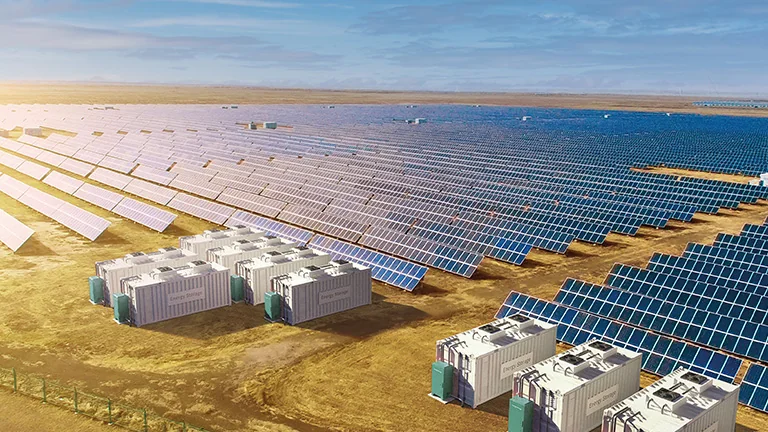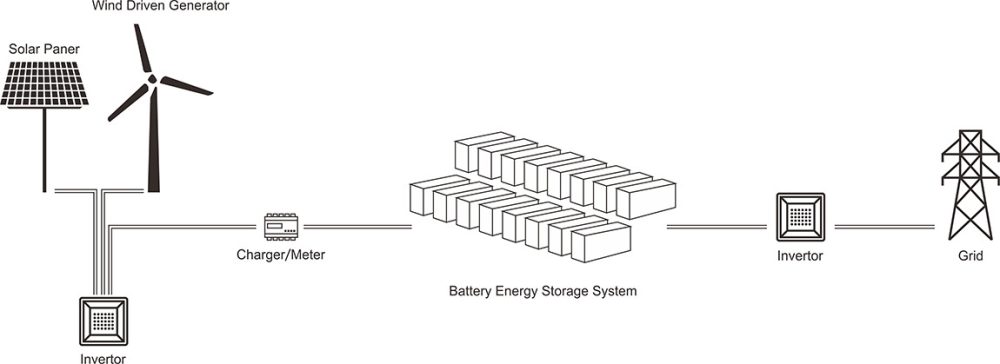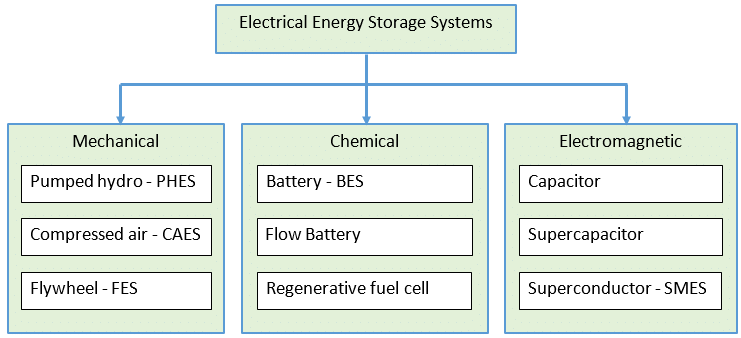
With the increasing popularity of intermittent renewable energy sources, large-scale power storage has become a focus of attention.Pumped storage technologies have matured. Other megawatt-scale technologies are under development. These technologies can provide dispatchable capacity on demand.
As a complement to intermittent renewable energy sources, energy storage must be able to meet demand for multiple days, not just a few hours.At the household level, behind the meter, battery storage is being promoted to complement solar PV installations. It reduces demand on the grid, especially during evening peaks in electricity consumption.
Electricity energy storage is a technology that utilizes various energy storage devices or facilities to store electrical energy in the grid. It can effectively balance grid supply and demand and improve grid stability.
The main roles of power storage are:
1. Peak and valley load regulation. Charging energy storage in the trough of electricity consumption, discharging in the peak of electricity consumption, smoothing the power load curve, improve the efficiency of the power grid.
2. Frequency regulation. Fast charging and discharging to regulate the frequency of the power grid, to maintain the stable operation of the power grid.
3. Alternative backup. Provide backup power when the power grid fails to enhance the reliability of power supply.
4. Capacity backup. To meet the power demand of short-term load growth of the grid.
5. New energy grid connection. Storing and regulating the intermittent power fluctuation of new energy generation.
6. Power quality improvement. Provide reactive power compensation, voltage regulation and other functions.

In many parts of the world, the rapid growth of intermittent renewable energy sources, particularly wind and solar power capacity, has led to strong incentives for large-scale development of electrical energy storage. Due to the naturally fluctuating annual growth rates of electrical energy from renewable energy technologies such as solar PV and wind. (Which are characterized by relatively low load factors.) It is expected that in the future, the total installed capacity of these technologies is expected to be far greater than conventional peak electricity demand in the future.
The extent to which electricity storage is developed will determine the extent to which these intermittent renewables can displace dispatchable energy sources. and in some cases utilize surplus power and bridge intermittent gaps.
In addition, some of the stored energy will typically need to be available in the form of electricity for days or weeks. Cost-effectiveness is key, and it is therefore important to clearly identify values and costs in order to compare different electricity storage technologies across a range of applications and services.
Different Energy Storage for Electricity
Electricity itself cannot be stored on any scale, but it can be converted into other forms of energy that can be stored and then converted back into electricity when needed.
Electrical storage system include batteries, flywheels, compressed air and pumped storage. The total amount of energy stored in any system is limited. Its energy capacity is measured in megawatt-hours (MWh). And its power, or maximum output for a given time, is measured in megawatts of electricity (MW or MWe).

Electrical energy storage media are:
- Battery. Mainly lead-acid batteries, sodium-sulfur batteries, lithium-ion batteries, etc.
- Super capacitors. The use of capacitance to store electric energy.
- Water pump energy storage. Using the potential energy of water to store electricity.
- Compressed air energy storage. Converting electrical energy into potential energy storage of compressed air.
- Flywheel energy storage. Storing kinetic energy by rotating a flywheel.
- Superconducting Magnetic Energy Storage. Storing magnetic energy with superconducting electromagnetic coils.
Power energy storage technology can significantly improve the operating efficiency and reliability of the power system, is one of the key technologies of the power grid. Compared with the traditional power station, it has the advantages of rapid response and low loss.
Electrical storage system can be designed to provide ancillary services to the transmission system, including frequency control. Which is currently the primary role of grid-scale batteries. Of course, fossil and nuclear fuels can enable very effective energy storage prior to generation.
While the focus here is on post-generation energy storage, particularly for intermittent renewable energy sources, any proper consideration of this issue will also need to include nuclear fuels for power generation, which are a more economical option with relatively low material requirements.
Summary
The development of power energy storage technology confronts many technical and economic challenges. Continuous innovation and progress are needed to reduce the cost of electrical storage system, increase the efficiency of energy storage, and improve the integration with the grid.
However, it is clear that power storage plays an increasingly important role in optimizing grid operation and integrating renewable energy sources. It can help build an efficient, safe and reliable power system and facilitate the transition to a sustainable energy future. With the maturity of storage technologies and application models, power storage will create environmental and economic benefits for society on a wider scale.
Rated Energy Battery Storage Connectors

CONTACT US
Renhotec was established in May 2005 and has been specialized in manufacturing and exporting various electronic connectors for over 15 years.
If you have any needs regarding connectors, please contact us via the phone number or email below
Mobile:(+86)18086610187
Email:[email protected]
*For the above mentioned electrical energy storage, we can provide related energy storage products. For example, connectors and wiring harnesses for energy storage. If you want to know more about our products, please contact usCopy!








Energy storage systems are essential for ensuring the stability and reliability of renewable energy sources like solar and wind power. 🌞💨 As these intermittent sources become more widespread, technologies like batteries, flywheels, and compressed air storage are helping to balance supply and demand, improve grid performance, and support energy independence. 🌍⚡ It’s exciting to see how innovations in energy storage will continue to optimize power systems and make renewables more efficient and cost-effective. With further advancements, we’ll move even closer to a greener and more sustainable energy future! 🌱
Energy storage systems are essential for balancing grid supply and demand, particularly with renewable energy sources like solar and wind. These systems store excess energy when demand is low and release it during peak times, improving grid reliability. Technologies like batteries, flywheels, and pumped storage are key to this process, supporting renewable energy integration and ensuring a stable power supply. As storage technology evolves, it will play a crucial role in building a sustainable energy future.